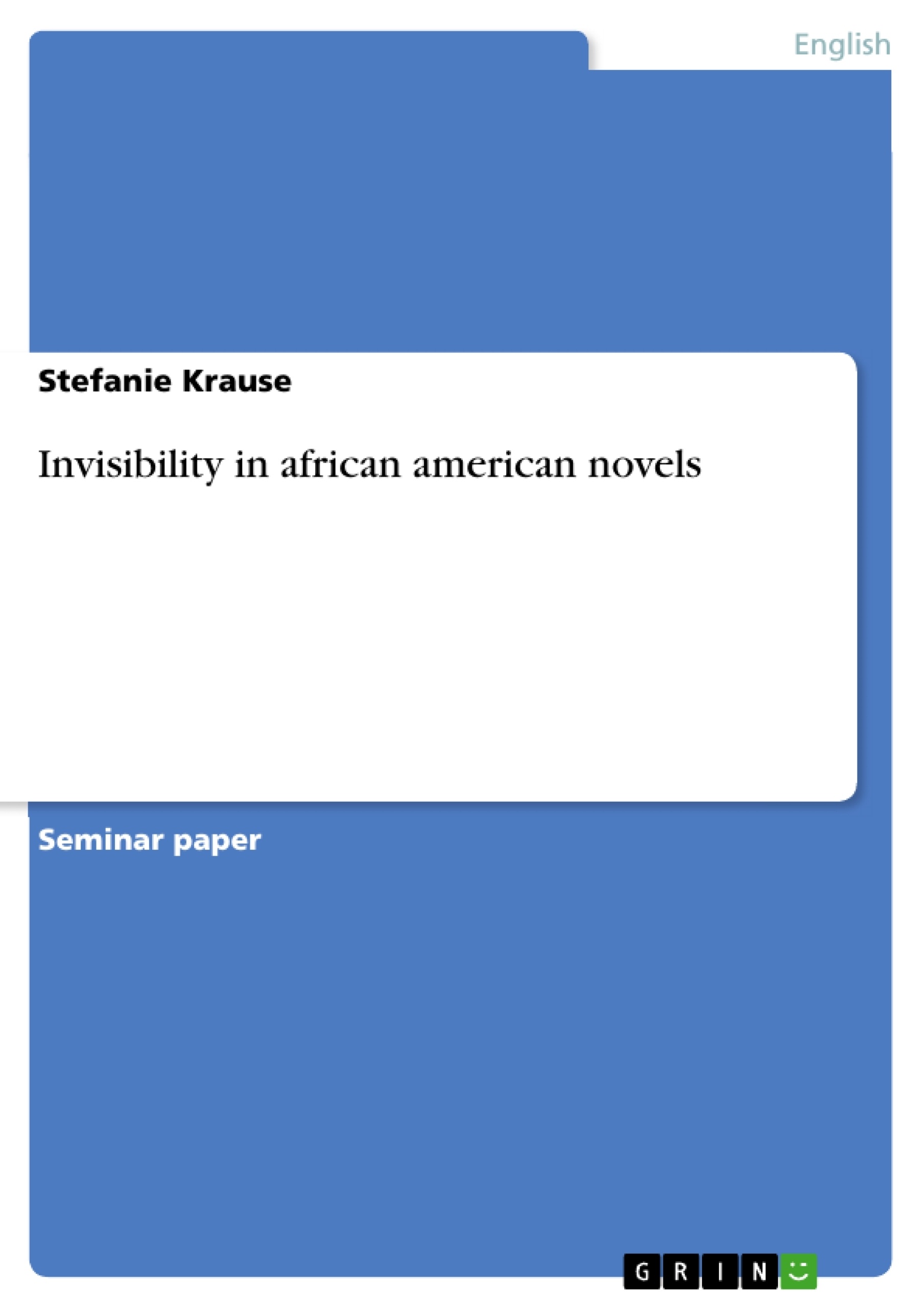Blindness is a topic in many African American novels published in the middle of the 20th century. However, this does not mean that black protagonists are over-averaged disabled. The inability of seeing refers more to a special type of blindness: a psychical one. This kind of disablement is “a matter of the construction of [the] inner eyes, those eyes with which [one] look[s] through [the] physical eyes upon reality” (Ellison, Ralph. Invisible Man. London: Penguin Books, 1965. p.7).
It is a way of refusing to recognise people and their character traits, which African Americans were often confronted with. This ignorance of the - mainly - “white” society is picked out as a central theme in many African American novels and, therefore, it will be the topic of this publishing. To prove this thesis, the following analysis will examine some example scenes from Ralph Ellison’s 1952 published novel Invisible Man. As one single book is not sufficient to establish a thesis for a whole genre, additionally scenes from Richard Wright’s 1940 published novel Native Son and Ann Petry’s 1946 published novel The Street will be briefly analysed. Even though a comparison between all three novels would have been interesting as well, this work will take its main focus on one single novel, to go as deeply into detail as the limited space allows, instead of giving only a cursory overview of different works. For the same reason, this work will not contain a summary of the discussed novels as these are expected to be known.
As the title of the work probably raises the expectation of an analysis of the physical blindness, this topic will be worked out in the second chapter, concentrating on Invisible Man, and, later on, briefly on Native Son. The attempts to point out its metaphorical meaning and to connect this with the psychical blindness will be made.
The main part of the analysis will be the examination of the psychical blindness that affects the main protagonist as well as the minor characters of Invisible Man. A closer look will be taken at the repeated eye-metaphors as well as at the function of the telling names. Referring to the title of the book, the attempt to answer the question, if invisibility is a result of blindness, will be made.
To prove that Ellison’s novel is not the only one that deals with the topic of blindness, the fourth and fifth chapter will deal with Petry’s and Wright’s novels that were published in the same period.
Inhaltsverzeichnis (Table of Contents)
- Introduction
- Physical blindness
- Psychical blindness
- Meaning of psychical blindness
- The eye-metaphors
- The blindfolds
- The third eye
- Rinehard's sunglasses
- Telling names
- Reverend Homer A. Barbee
- Brother Jack
- Invisibility as a result of blindness?
- Native Son
- Physical blindness
- Psychical blindness
- Bigger's own blindness
- The blindness of Bigger's surrounding
- The Street
- The blindness of Lutie's surrounding
- Lutie's own blindness
- Telling names
- Mrs. Hedges
- Min
- Conclusion
Zielsetzung und Themenschwerpunkte (Objectives and Key Themes)
The main objective of this paper is to analyze the concept of blindness, both physical and psychical, as a recurring theme in African American novels published in the mid-20th century. The paper specifically focuses on how this blindness reflects the social and racial realities of the time, particularly the ignorance and prejudice directed towards African Americans.
- Psychical blindness as a central theme in African American novels
- The use of eye-metaphors to highlight the theme of blindness
- The significance of telling names in reflecting character blindness
- Exploring the connection between blindness and invisibility in these novels
- The exploration of physical and psychical blindness in selected works by Ralph Ellison, Richard Wright, and Ann Petry
Zusammenfassung der Kapitel (Chapter Summaries)
The introduction establishes the prevalence of the blindness theme in African American novels of the mid-20th century, emphasizing psychical blindness as a central theme that highlights the social and racial context of the time. The paper focuses on analyzing select scenes from Ralph Ellison's "Invisible Man," with additional references to Richard Wright's "Native Son" and Ann Petry's "The Street" to demonstrate the broader context of this theme.
Chapter 2 explores the role of physical blindness in "Invisible Man" and "Native Son." The chapter analyzes the symbolic function of blind characters, such as Reverend Homer A. Barbee and Brother Jack in "Invisible Man," and Mrs. Dalton in "Native Son," to represent the psychical blindness of other characters.
Chapter 3 delves into the concept of psychical blindness in "Invisible Man," examining its impact on the main protagonist and minor characters. This chapter analyzes recurring eye-metaphors throughout the novel and explores the significance of telling names in reflecting the characters' blindness. It also attempts to answer the question of whether invisibility is a result of blindness.
Chapter 4 briefly examines the themes of physical and psychical blindness in Richard Wright's "Native Son," focusing on Bigger Thomas's own blindness and the blindness of his surroundings.
Chapter 5 further explores the theme of blindness in Ann Petry's "The Street," focusing on the blindness of Lutie Johnson's surroundings and her own personal blindness. The chapter analyzes the significance of telling names like Mrs. Hedges and Min in reflecting the characters' blindness.
Schlüsselwörter (Keywords)
The primary keywords and focus topics of this paper include psychical blindness, physical blindness, African American novels, social commentary, racial prejudice, eye-metaphors, telling names, Ralph Ellison, "Invisible Man," Richard Wright, "Native Son," Ann Petry, "The Street."
- Citar trabajo
- Stefanie Krause (Autor), 2006, Invisibility in african american novels, Múnich, GRIN Verlag, https://www.grin.com/document/66824



